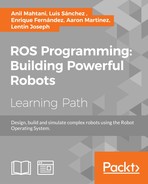If you want more processing power than a Raspberry Pi board and with the same form factor, then Odroid is for you. The Odroid-C2 and Odroid-XU4 are the latest Odroid models, with 1.5 GHz and 2 GHz quad-core processors and 2 GB RAM, and almost the same power consumption as the RPi.
Odroid can be loaded with the latest version of Ubuntu, Android, and many flavors of Linux. It is a good choice if you are planning for an embedded powerhouse in a very small form factor. Let's discuss some of the models of Odroid.
The Odroid-XU4 is the most powerful and expensive board in the series. This board is ideal for running ROS and image-processing application. It has eight cores running at 2 GHz and with 2 GB of RAM.
The ODROID-C2 runs at 1.5 GHz, on a quad-core processor with 2 GB of RAM. The Odroid-C1+ and C1 have almost the same configuration as the C2, with the main difference being that the C1/C1+ only have 1 GB RAM, as opposed to the C2's 2 GB. These two boards are priced almost the same as Raspberry Pi's high-end boards. They are clear competitors to the Raspberry Pi.

This subsection should be enough for you to get an idea of popular embedded boards that can be used for robots. Next, we can start discussing interfacing ROS with some of these boards. We are not going to discuss too deeply about the interfacing concept; rather than that, we will mainly focus on the procedures to get the board ready to work with ROS. We will also learn about some of the sensor interfacing, using which we can read sensor values using a controller board and read into ROS.
